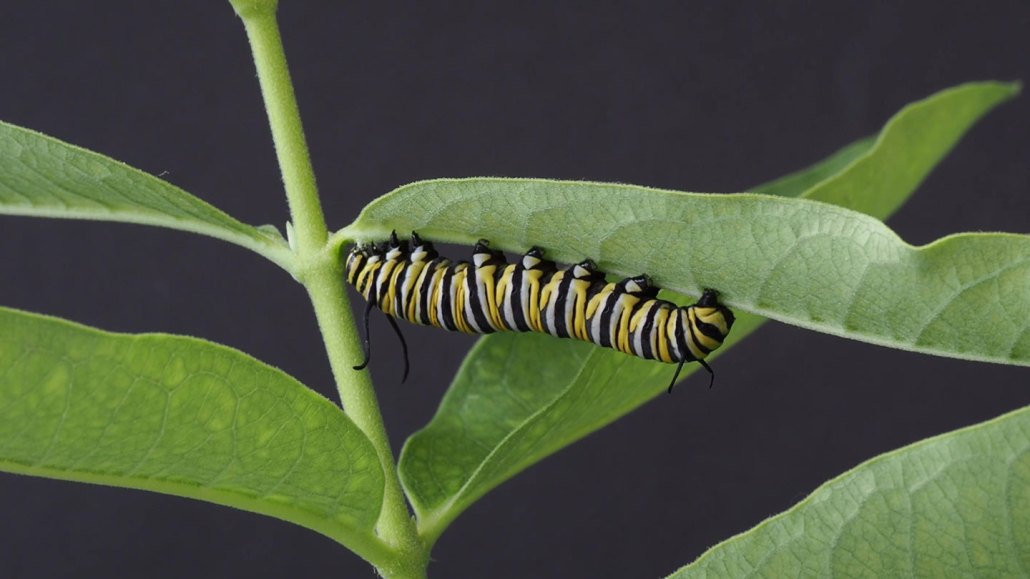
About to binge-drink from a milkweed plant, a nearly grown monarch butterfly caterpillar positions itself to bite into a leaf stalk and lap up the toxin-rich plant fluid that will bleed out.
Anja Betz
Maybe science has misunderstood the dining style of big monarch butterfly caterpillars. What insect watchers have called defense against the toxic latex a milkweed plant oozes may not be avoidance at all. Instead of dodging the plants’ sticky, white toxic goo, the plump, older caterpillars could be gorging on it.
Monarch caterpillars (Danaus plexippus) hatch and feed on milkweeds, which fight back when bitten and ooze milky toxin-rich latex. Monarchs evolved their own counter-chemistry for surviving the toxins. Yet that plant latex can still kill by sheer gooeyness, explains ecologist Georg Petschenka of University of Hohenheim in Stuttgart, Germany. Very tiny, recently hatched caterpillars can get fatally stuck with mouthparts clogged.
Caterpillars, however, can get around milkweed sticky traps by nipping leaf stalks and then waiting for the latex channels to bleed out. A swath of killer leaf becomes a harmless vegetable.
For older caterpillars strong enough to risk glue, Petschenka argues, those bleed-out cuts can do more than disarm a leaf. By this stage, the monarch caterpillars feast on the latex itself. Offering them a pipette loaded with latex to suckle showed they drink it readily and build up their own defensive reserves of milkweed toxins, he and entomologists Anja Betz and Robert Bischoff, also at Hohenheim, reported February 21 in Proceedings of the Royal Society B.
The older caterpillars dip their mouthparts in latex “like a little cat drinking milk,” Petschenka says.
Usually, the toxins, called cardenolides, attack an animal enzyme that’s crucial to cells for keeping potassium and sodium concentrations in balance. Monarch caterpillars, however, can convert some of the milkweed cardinolides into less toxic forms. These build up as lifelong deterrents against predators such as birds.
It was thought that monarchs gain most of that protection from nibbling the leafy greens, not going for milkweed’s vascular system. But the idea that the bigger caterpillars might be harvesting latex as protection has floated around now and then, perhaps starting with the early 20th century British pioneer of chemical ecology, Miriam Rothschild. Another idea has been that caterpillars working on leaf cuts will drink latex “to get the sticky noxious fluid out of the way,” says insect ecologist David Dussourd, at the University of Central Arkansas in Conway, who has noticed the latex licking before.
But it’s not obvious behavior. “I have never seen monarch caterpillars drinking beads of latex sap from milkweed, but now after reading this finding, I am going to pay more attention to what they are doing,” says ecologist Sonia Altizer of the University of Georgia in Athens.
What triggered Petschenka’s curiosity was noticing that he didn’t see latex left at a wound after big caterpillars ate. “We would expect this to flow out and then maybe to dry up,” he says. So maybe those cuts were not made to avoid mouthfuls of cardenolide toxins but to find some.
He and his team found a variety of evidence supporting the idea that older monarch caterpillars are toxin-loading. For instance, the researchers saw them now and then just settling down to feed on a leaf instead of making a preliminary bite and waiting for latex to drain. That never happened with comparison caterpillars of a Euploea species that will eat milkweed but not stash its toxins. These non-sequestering diners always drained latex from lab leaves before dining.
Also, the young monarch caterpillars themselves offered a monarch-to-monarch comparison. The very young ones avoided latex, but when older, they shifted to “eager drinking,” the researchers say.
These findings and others in the paper got a hard look from evolutionary biologist Anurag Agrawal of Cornell University. Even though he admires Miriam Rothschild and had supervised Petschenka’s Ph.D., Agrawal for years dismissed caterpillar latex-sipping as “a necessary evil.” The only way for a caterpillar “to successfully deactivate the pressurized latex was to suck it up,” he wrote in his 2017 book Monarchs and Milkweed. Now, however, he says, “the study changed my mind.”





